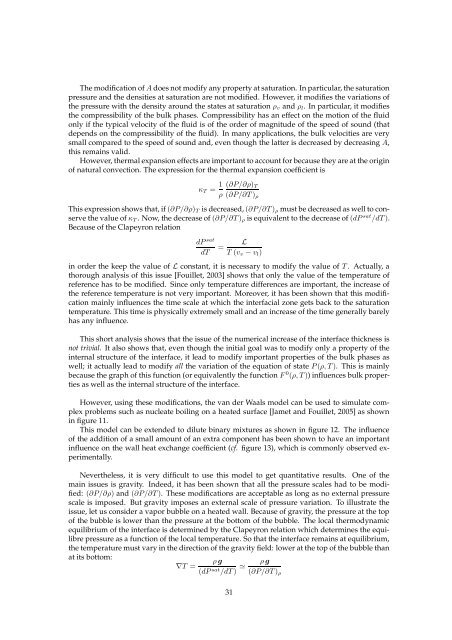Diffuse interface models in fluid mechanics
Diffuse interface models in fluid mechanics
Diffuse interface models in fluid mechanics
You also want an ePaper? Increase the reach of your titles
YUMPU automatically turns print PDFs into web optimized ePapers that Google loves.
The modification of A does not modify any property at saturation. In particular, the saturationpressure and the densities at saturation are not modified. However, it modifies the variations ofthe pressure with the density around the states at saturation ρ v and ρ l . In particular, it modifiesthe compressibility of the bulk phases. Compressibility has an effect on the motion of the <strong>fluid</strong>only if the typical velocity of the <strong>fluid</strong> is of the order of magnitude of the speed of sound (thatdepends on the compressibility of the <strong>fluid</strong>). In many applications, the bulk velocities are verysmall compared to the speed of sound and, even though the latter is decreased by decreas<strong>in</strong>g A,this rema<strong>in</strong>s valid.However, thermal expansion effects are important to account for because they are at the orig<strong>in</strong>of natural convection. The expression for the thermal expansion coefficient isκ T = 1 ρ(∂P/∂ρ) T(∂P/∂T ) ρThis expression shows that, if (∂P/∂ρ) T is decreased, (∂P/∂T ) ρ must be decreased as well to conservethe value of κ T . Now, the decrease of (∂P/∂T ) ρ is equivalent to the decrease of (dP sat /dT ).Because of the Clapeyron relationdP satdT = LT (v v − v l )<strong>in</strong> order the keep the value of L constant, it is necessary to modify the value of T . Actually, athorough analysis of this issue [Fouillet, 2003] shows that only the value of the temperature ofreference has to be modified. S<strong>in</strong>ce only temperature differences are important, the <strong>in</strong>crease ofthe reference temperature is not very important. Moreover, it has been shown that this modificationma<strong>in</strong>ly <strong>in</strong>fluences the time scale at which the <strong>in</strong>terfacial zone gets back to the saturationtemperature. This time is physically extremely small and an <strong>in</strong>crease of the time generally barelyhas any <strong>in</strong>fluence.This short analysis shows that the issue of the numerical <strong>in</strong>crease of the <strong><strong>in</strong>terface</strong> thickness isnot trivial. It also shows that, even though the <strong>in</strong>itial goal was to modify only a property of the<strong>in</strong>ternal structure of the <strong><strong>in</strong>terface</strong>, it lead to modify important properties of the bulk phases aswell; it actually lead to modify all the variation of the equation of state P (ρ, T ). This is ma<strong>in</strong>lybecause the graph of this function (or equivalently the function F 0 (ρ, T )) <strong>in</strong>fluences bulk propertiesas well as the <strong>in</strong>ternal structure of the <strong><strong>in</strong>terface</strong>.However, us<strong>in</strong>g these modifications, the van der Waals model can be used to simulate complexproblems such as nucleate boil<strong>in</strong>g on a heated surface [Jamet and Fouillet, 2005] as shown<strong>in</strong> figure 11.This model can be extended to dilute b<strong>in</strong>ary mixtures as shown <strong>in</strong> figure 12. The <strong>in</strong>fluenceof the addition of a small amount of an extra component has been shown to have an important<strong>in</strong>fluence on the wall heat exchange coefficient (cf. figure 13), which is commonly observed experimentally.Nevertheless, it is very difficult to use this model to get quantitative results. One of thema<strong>in</strong> issues is gravity. Indeed, it has been shown that all the pressure scales had to be modified:(∂P/∂ρ) and (∂P/∂T ). These modifications are acceptable as long as no external pressurescale is imposed. But gravity imposes an external scale of pressure variation. To illustrate theissue, let us consider a vapor bubble on a heated wall. Because of gravity, the pressure at the topof the bubble is lower than the pressure at the bottom of the bubble. The local thermodynamicequilibrium of the <strong><strong>in</strong>terface</strong> is determ<strong>in</strong>ed by the Clapeyron relation which determ<strong>in</strong>es the equilibrepressure as a function of the local temperature. So that the <strong><strong>in</strong>terface</strong> rema<strong>in</strong>s at equilibrium,the temperature must vary <strong>in</strong> the direction of the gravity field: lower at the top of the bubble thanat its bottom:ρ g∇T =(dP sat /dT ) ≃ ρ g(∂P/∂T ) ρ31











![[Diffusion-Limited Aggregation - A Model for Pattern Formation].](https://img.yumpu.com/52395246/1/190x245/diffusion-limited-aggregation-a-model-for-pattern-formation.jpg?quality=85)




